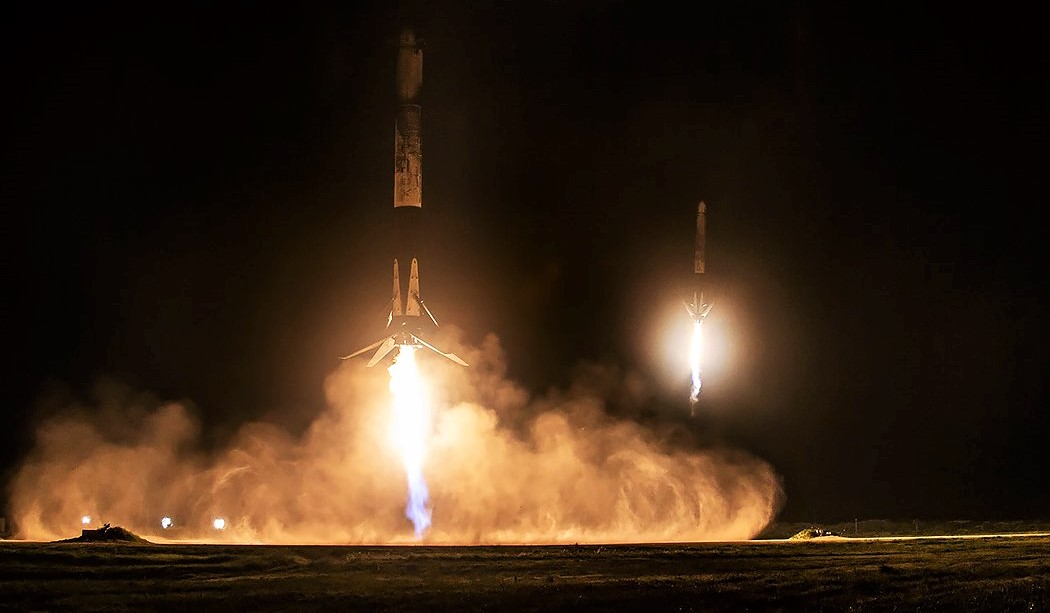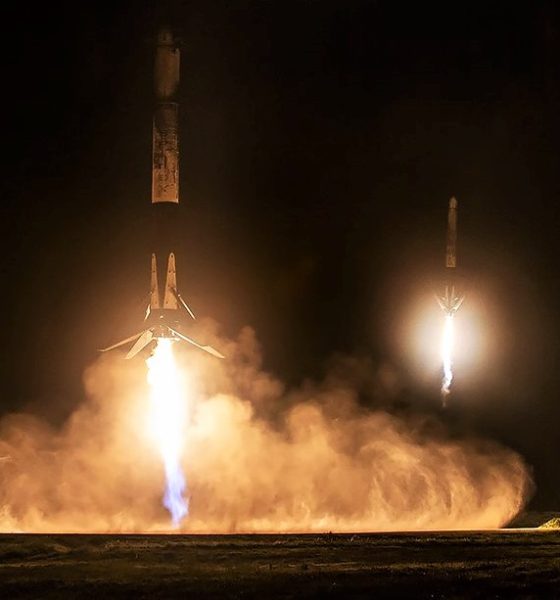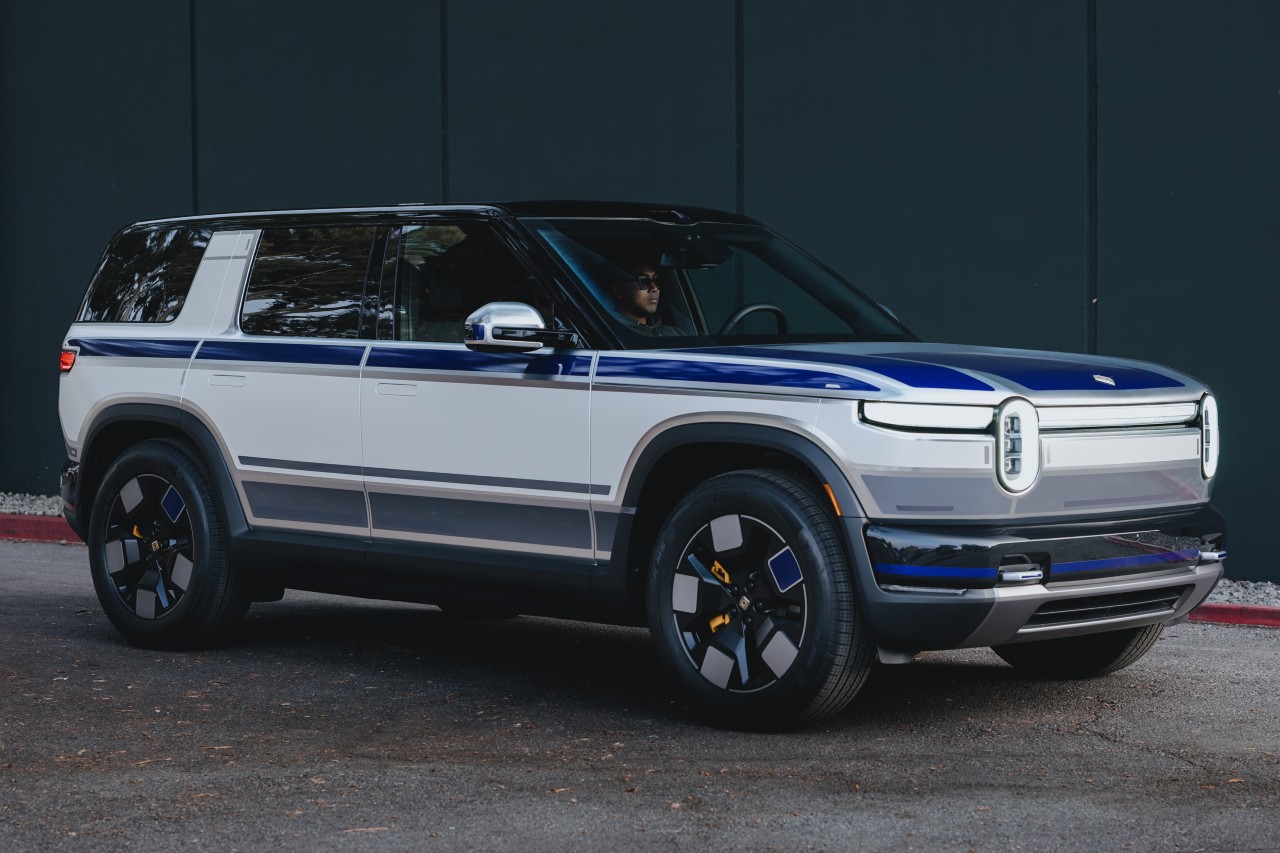

News
SpaceX’s next Falcon Heavy launch and landing could be more than a year away
According to comments made by US Air Force officials prior to SpaceX’s latest Falcon Heavy launch, the payload assigned to the military’s first fully-certified Falcon Heavy has been swapped with another, although the mission’s late-2020 launch target remains relatively unchanged.
This new information comes on the heels of the June 25th launch of Space Test Program 2 (STP-2), SpaceX’s third successful Falcon Heavy mission and a huge milestone for the rocket’s future as a competitive option for US military launches. Perhaps most importantly, it confirms – barring a surprise launch contract or internal Starlink mission – that Falcon Heavy’s next (and fourth) launch is unlikely to occur until late next year, a gap of at least 15-17 months.
Announced roughly four months after Falcon Heavy’s inaugural February 2018 launch debut, the USAF contracted with SpaceX to launch the ~6350 kg (14,000 lb) AFSPC-52 satellite no earlier than (NET) September 2020. In February 2019, Department of Defense contract announcements revealed that SpaceX had been awarded three military launch contracts, two for the National Reconnaissance Office (NROL-85 & NROL-87) and one for the USAF (AFSPC-44), all tentatively scheduled to launch in 2021.
First reported by Spaceflight Now, Col. Robert Bongiovi – director of the launch enterprise systems directorate at the Air Force’s Space and Missile Systems Center (AFSMC) – recently indicated that AFSPC-44 – not AFSPC-52 – is now scheduled to be the US military’s first post-certification Falcon Heavy launch. 52 and 44 have essentially swapped spots, with AFSPC-44 moving forward to NET Q4 (fall) 2020 while AFSPC-52 has been delayed to NET Q2 (spring) 2021.

The trouble with launch gaps
Although Bongiovi did not explicitly state that AFSPC-44 will be SpaceX’s next Falcon Heavy launch, there are no publicly-disclosed missions set to launch on the rocket in the interim. That could theoretically change, especially if SpaceX has plans to launch the massive rocket in support of an internal Starlink mission or even something more exotic, but the loss of both Block 5 center core B1055 and B1057 means that the company will have to build an entirely new center core.
SpaceX’s Falcon Heavy lead times are far superior to competitor ULA’s Delta IV Heavy production line, but the process of manufacturing new center cores is still quite lengthy. Critically, Falcon Heavy Block 5 center cores require strengthened octawebs, custom interstages, and propellant tanks that are significantly thicker than those used on Falcon 9. For all intents and purposes, a center core is a totally different rocket relative to a Falcon 9 booster, the latter being SpaceX’s primary focus at the company’s assembly line-style Hawthorne factory. It’s theoretically possible for a dedicated Falcon Heavy center core build to be expedited or leapfrogged forward in the production queue, but most long-lead Falcon 9 booster hardware physically cannot be redirected to speed up center core production.

Unless SpaceX was already in the process of building a new center core prior B1057’s unsuccessful landing attempt, it’s safe to assume that the next custom Falcon Heavy booster is unlikely to be completed until early 2020, if not later. In theory, this means that Falcon Heavy could be dormant for no less than 16 months between STP-2 and its next launch. Traditionally, that sort of lengthy gap between launches has been frowned upon by NASA, ULA, and oversight groups like GAO. If a given rocket doesn’t launch for a year or more, it can potentially pose a risk to reliability and raise costs as its production and launch teams have no satisfactory way to fully preserve their technical expertise.
This can be compared to attempting to become an expert at a musical instrument while only having access to said instrument one or two months a year, essentially impossible. In fact, at one point, NASA hoped to require its Space Launch System (SLS) rocket be able to launch no less than once per year, partly motivated by a desire to mitigate some of the deterioration that can follow extremely low launch cadences. Years later, financial constraints and years upon years of delays and budget overruns have made such a cadence effectively impossible for SLS/Orion, but the fact remains that launching a rocket just once every 18-24 months is likely to inflate both costs and risks.


Thankfully, SpaceX’s Falcon Heavy could scarcely be more different than NASA’s SLS and the retired Space Shuttle it derives most of its hardware from. Even if all things are held equal and not flying a Falcon Heavy center core for 16+ months increases risk and cost, center cores are still heavily derived from Falcon 9 booster technology, including plumbing, avionics, attitude control thrusters, Merlin 1D engines, landing legs, and launch facilities.
Furthermore, the center core is just one of five distinct assemblies that make up a given Falcon Heavy. Both side boosters are effectively Falcon 9 Block 5 boosters with nose cones instead of interstages and slight modifications to support booster attachment hardware, while the upper stage and payload fairing are the same for all Falcon launches. In other words, SpaceX’s workforce will continue to build, launch, land, and reuse dozens of Falcon 9 boosters – as well as upper stages payload fairings – between now and Falcon Heavy Flight 4, even if it’s NET Q4 2020. In a worst-case scenario, SpaceX production and launch staff will be unfamiliar and inexperienced with maybe 20% of Falcon Heavy – at least in a very rough sense. Even then, much of that unfamiliarity may still be tempered by the fact that Falcon Heavy center cores share a large amount of commonality with the Falcon 9 first stages SpaceX’s workforce will remain deeply familiar with.
Indeed, Falcon Heavy’s second launch has already demonstrated this to some extent, occurring without issue more than 14 months after the rocket’s inaugural launch. It seems that the only real loss incurred by a ~16-month delay between Flights 3 and 4 will be having to wait another year (or more) to witness Falcon Heavy’s next launch.
Check out Teslarati’s Marketplace! We offer Tesla accessories, including for the Tesla Cybertruck and Tesla Model 3.

News
Tesla’s northernmost Supercharger in North America opens

Tesla has opened its northernmost Supercharger in Fairbanks, Alaska, with eight V4 stalls located in one of the most frigid cities in the U.S.
Located just 196 miles from the Arctic Circle, Fairbanks’s average temperature for the week was around -12 degrees Fahrenheit. However, there are plenty of Tesla owners in Alaska who have been waiting for more charging options out in public.
There are only 36 total Supercharger stalls in Alaska, despite being the largest state in the U.S.
Eight Superchargers were added to Fairbanks, which will eventually be a 48-stall station. Tesla announced its activation today:
North America’s northernmost Supercharger Fairbanks, AK (8 stalls) opened to public. https://t.co/M4l04DZ6B5 pic.twitter.com/zyL6bDuA93
— Tesla Charging (@TeslaCharging) December 12, 2025
The base price per kWh is $0.43 at the Fairbanks Supercharger. Thanks to its V4 capabilities, it can charge at speeds up to 325 kW.
Despite being the northernmost Supercharger in North America, it is not even in the Top 5 northernmost Superchargers globally, because Alaska is south of Norway. The northernmost Supercharger is in Honningsvåg, Norway. All of the Top 5 are in the Scandanavian country.
Tesla’s Supercharger expansion in 2025 has been impressive, and although it experienced some early-quarter slowdowns due to V3-to-V4 hardware transitions, it has been the company’s strongest year for deployments.
🚨🚨 Tesla Supercharging had a HUGE year, and they deserve to be recognized.
🍔 Opened Tesla Diner, a drive-in movie theater with awesome, Chef-curated cuisine
🔌 Gave access to Superchargers to several EV makers, including Hyundai, Genesis, Mercedes-Benz, Kia, Lucid, Toyota,… pic.twitter.com/yYT2QEbqoW
— TESLARATI (@Teslarati) December 10, 2025
Through the three quarters of 2025, the company has added 7,753 stations and 73,817 stalls across the world, a 16 percent increase in stations and an 18 percent increase in stalls compared to last year.
Tesla is on track to add over 12,000 stalls for the full year, achieving an average of one new stall every hour, an impressive statistic.
Recently, the company wrapped up construction at its Supercharger Oasis in Lost Hills, California, a 168-stall Supercharger that Tesla Solar Panels completely power. It is the largest Supercharger in the world.
News
Tesla hints toward Premium Robotaxi offering with Model S testing
Why Tesla has chosen to use a couple of Model S units must have a reason; the company is calculated in its engineering and data collection efforts, so this is definitely more than “we just felt like giving our drivers a change of scenery.”

Tesla Model S vehicles were spotted performing validation testing with LiDAR rigs in California today, a pretty big switch-up compared to what we are used to seeing on the roads.
Tesla utilizes the Model Y crossover for its Robotaxi fleet. It is adequately sized, the most popular vehicle in its lineup, and is suitable for a wide variety of applications. It provides enough luxury for a single rider, but enough room for several passengers, if needed.
However, the testing has seemingly expanded to one of Tesla’s premium flagship offerings, as the Model S was spotted with the validation equipment that is seen entirely with Model Y vehicles. We have written several articles on Robotaxi testing mules being spotted across the United States, but this is a first:
🚨 Tesla is using Model S vehicles fitted with LiDAR rigs to validate FSD and Robotaxi, differing from the Model Ys that it uses typically
Those Model Y vehicles have been on the East Coast for some time. These Model S cars were spotted in California https://t.co/CN9Bw5Wma8 pic.twitter.com/UE55hx5mdd
— TESLARATI (@Teslarati) December 11, 2025
Why Tesla has chosen to use a couple of Model S units must have a reason; the company is calculated in its engineering and data collection efforts, so this is definitely more than “we just felt like giving our drivers a change of scenery.”
It seems to hint that Tesla could add a premium, more luxury offering to its Robotaxi platform eventually. Think about it: Uber has Uber Black, Lyft has Lyft Black. These vehicles and services are associated with a more premium cost as they combine luxury models with more catered transportation options.
Tesla could be testing the waters here, and it could be thinking of adding the Model S to its fleet of ride-hailing vehicles.
Reluctant to remove the Model S from its production plans completely despite its low volume contributions to the overall mission of transitioning the world to sustainable energy, the flagship sedan has always meant something. CEO Elon Musk referred to it, along with its sibling Model X, as continuing on production lines due to “sentimental reasons.”
However, its purpose might have been expanded to justify keeping it around, and why not? It is a cozy, premium offering, and it would be great for those who want a little more luxury and are willing to pay a few extra dollars.
Of course, none of this is even close to confirmed. However, it is reasonable to speculate that the Model S could be a potential addition to the Robotaxi fleet. It’s capable of all the same things the Model Y is, but with more luxuriousness, and it could be the perfect addition to the futuristic fleet.
News
Rivian unveils self-driving chip and autonomy plans to compete with Tesla
Rivian, a mainstay in the world of electric vehicle startups, said it plans to roll out an Autonomy+ subscription and one-time purchase program, priced at $49.99 per month and $2,500 up front, respectively, for access to its self-driving suite.

Rivian unveiled its self-driving chip and autonomy plans to compete with Tesla and others at its AI and Autonomy Day on Thursday in Palo Alto, California.
Rivian, a mainstay in the world of electric vehicle startups, said it plans to roll out an Autonomy+ subscription and one-time purchase program, priced at $49.99 per month and $2,500 up front, respectively, for access to its self-driving suite.
CEO RJ Scaringe said it will learn and become more confident and robust as more miles are driven and it gathers more data. This is what Tesla uses through a neural network, as it uses deep learning to improve with every mile traveled.
He said:
“I couldn’t be more excited for the work our teams are driving in autonomy and AI. Our updated hardware platform, which includes our in-house 1600 sparse TOPS inference chip, will enable us to achieve dramatic progress in self-driving to ultimately deliver on our goal of delivering L4. This represents an inflection point for the ownership experience – ultimately being able to give customers their time back when in the car.”
At first, Rivian plans to offer the service to personally-owned vehicles, and not operate as a ride-hailing service. However, ride-sharing is in the plans for the future, he said:
“While our initial focus will be on personally owned vehicles, which today represent a vast majority of the miles to the United States, this also enables us to pursue opportunities in the rideshare space.”
The Hardware
Rivian is not using a vision-only approach as Tesla does, and instead will rely on 11 cameras, five radar sensors, and a single LiDAR that will face forward.
It is also developing a chip in-house, which will be manufactured by TSMC, a supplier of Tesla’s as well. The chip will be known as RAP1 and will be about 50 times as powerful as the chip that is currently in Rivian vehicles. It will also do more than 800 trillion calculations every second.
Meet the Rivian Autonomy Processor.
Fast, smart, scalable and purpose-built for autonomous driving and the world of physical AI. Hitting the open road in 2026. pic.twitter.com/0wYXi5WKy7
— Rivian (@Rivian) December 11, 2025
RAP1 powers the Autonomy Compute Module 3, known as ACM3, which is Rivian’s third-generation autonomy computer.
ACM3 specs include:
- 1600 sparse INT8 TOPS (Trillion Operations Per Second).
- The processing power of 5 billion pixels per second.
- RAP1 features RivLink, a low-latency interconnect technology allowing chips to be connected to multiply processing power, making it inherently extensible.
- RAP1 is enabled by an in-house developed AI compiler and platform software
As far as LiDAR, Rivian plans to use it in forthcoming R2 cars to enable SAE Level 4 automated driving, which would allow people to sit in the back and, according to the agency’s ratings, “will not require you to take over driving.”
More Details
Rivian said it will also roll out advancements to the second-generation R1 vehicles in the near term with the addition of UHF, or Universal Hands-Free, which will be available on over 3.5 million miles of roadway in the U.S. and Canada.
More than any other feature, our owners have asked for more hands-free miles.
With Universal Hands-Free, you can now enjoy hands-free assisted driving on any road with clearly defined lanes. That’s roughly 3.5 million miles in the U.S. and Canada.
Look for it in our next… pic.twitter.com/ZFhwVzvt6b
— Rivian (@Rivian) December 11, 2025
Rivian will now join the competitive ranks with Tesla, Waymo, Zoox, and others, who are all in the race for autonomy.








